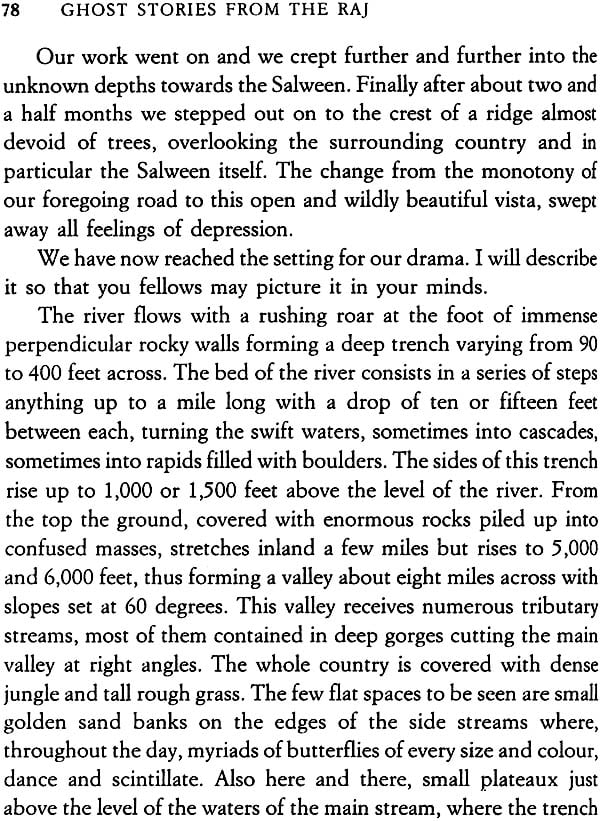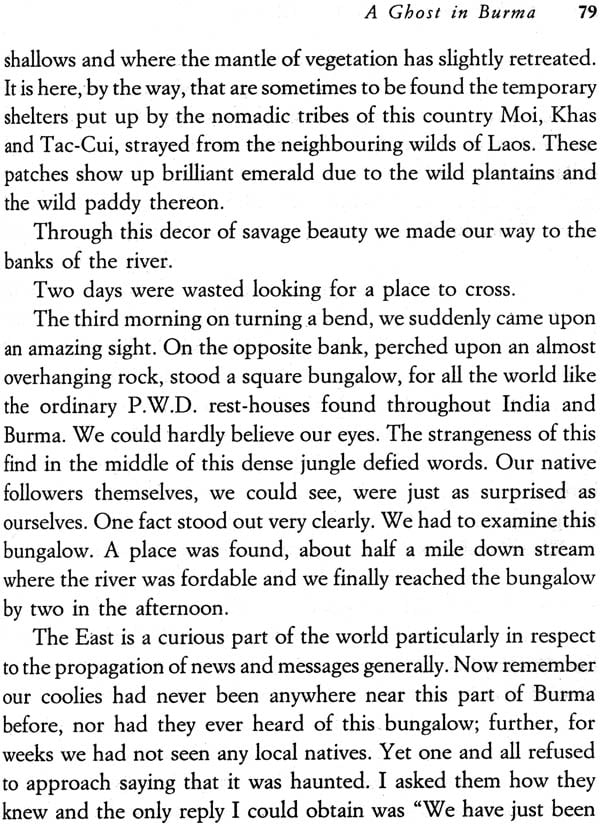
Ghost Stories from the Raj
Book Specification
| Item Code: | IDK431 |
| Author: | Ruskin Bond |
| Publisher: | Rupa Publication Pvt. Ltd. |
| Edition: | 2006 |
| ISBN: | 8171679927 |
| Pages: | 183 |
| Cover: | Paperback |
| Other Details | 8.0" X 5.4" |
| Weight | 180 gm |
Book Description
‘Ghosts don't require passports. They can turn up without pa pers in the most unexpected places!’
Over the years, Ruskin Bond’s interest in the supernatural has led him to collect ghost stories from all over the world. In this collection, he presents a picture of a 'haunted India', as seen and described by British writers, officials and travellers during the nineteenth and twentieth centuries. Some ghosts are scary, some sad and some funny, but all of them are entertaining. Including tales by Rudyard Kipling, Alice Perrin, C.A. Kincaid and John Eyton, this is a wonderful collection of tales that will delight readers, young and old alike.
Ruskin Bond has been writing for over sixty years, and has now over 120 titles in print-novels, collections of stories, poetry, essays, anthologies and books for children. His first novel, The Room on the Roof, received the prestigious John Llewellyn Rhys award in 1957. He has also received the Padma Shri, and two awards from the Sahitya Akademi- one for his short stories and another for his writings for children. In 2012, the Delhi government gave him its Lifetime Achievement award.
Born in 1934, Ruskin Bond grew up in Jamnagar, Shimla, New Delhi and Dehradun. Apart from three years in the UK, he has spent all his life in India, and now lives in Mussoorie with his adopted family.
A shy person, Ruskin says he likes being a writer because 'When I'm writing there's nobody watching me. Today, it's hard to find a profession where you're not being watched!'
Introduction
The Raison D'etre for Telling a Ghost Story Was probably best summed up by the Fat Boy in pickwick Papers, when he said: "I want to make your flesh creep!"
But it isn't always as simple as that, and not all ghosts are frightening.
The other night I woke up around midnight with bright moonlight streaming in at the window and lighting up the bedroom. Someone, or something-a vague, nebulous figure-was standing beside my bed, looking down at me. It could only have been a ghost. I waited for the spectre to say something but it remained silent; nor did it move away.
"Hello," I said. "And what can I do for you?"
No answer. Not even a gesture, either of goodwill or ill-will. A most ineffective ghost.
"Do you have a message for me?" I asked. "Anything you'd like me to do for you?"
No response. It just stood there, shimmering in the Moonlight "Well," I said, "I've got better things to do than just lie here holding a one-sided conversation." And I turned over and went to sleep again.
The ghosts in this collection are far more alarming. Most of them were observed, experienced or imagined by British writers during the period 1840 to 1940: a century of ghosts! The British are a phlegmatic people, not given to displaying much emotion or excitement, with the result that their supernatural experiences are quite convincing when put down on paper. When C.A. Kincaid of the Indian Civil Service described people who turned into panthers (or vice-versa), and mischievous spirits who entered the bodies of straitlaced Englishmen, we have to believe him. As we believe those who found themselves in haunted dak bungalows, graveyards, villages, forests, forts Haunted India, in fact! For the British, coming from a land where haunted houses and castles were the norm, were fascinated by the wonderful variety of supernatural manifestations that they found in India: churails (the ghosts of wayward women, whose feet always faced backwards), bhoots who took up residence in peepal trees, or mischievous prets (Indian poltergeists) who sometimes entered the homes of living people and created havoc in their lives. When I was a boy, one such prêt took up residence in my grandfather's house and made life hell for everyone-throwing dishes around, knocking pictures off walls, pulling the cat by the tail, and tying knots in my Uncle Ken's pyjamas-so much so, that we had to move to another house for a time. But the prêt followed us and would not leave until it had been propitiated with the help of a wandering mendicant. He taught me the following useful mantra :
Bhut, prêt, pisach, dana,
Shiv ka kehna, sab nikal jana!
(Ghosts ad spirits in house or tree,
In Shiv's great name we bid thee flee!)
Amongst the writers represented here, two were keen observers of Indian customs and folklore Lt. Col. Sleeman, an administrator who, in the mid-nineteenth century helped eliminate the menace of the Thugs, a sect who waylaid and murdered innocent travelers; and C.A. Kincaid, one of the more enlightened of British officials, who wrote sympathetic books and essays on Shivaji, the Rani of Jhansi, and other heroic figures. Kipling, poet of Empire, wrote the occasional ghost story; as did Alice Perrin, wife of an Indian official; her stories were quite popular in the 1920s. In Caulfield's Crime, she reveals the more arrogant, cruel aspect of the colonial official. In The Summoning of Arnold she demonstrates that the spirits of the dead recognize no frontiers. Ghosts require no passports. They are truly universal beings! Kincaid brings a touch of humour to his stories but this does not lessen their dramatic impact. The stories of this period tell us something about colonial attitudes-ranging from the paternalistic to the cynically indifferent-but we must remember that they were written purely to entertain, to enliven a dull railway journey, a sleepless night rainy day in the hills, a long sea voyage, or a period of recuperation from a tiring illness. Ghost stories are meant to frighten you, but at the back of your mind you know it's all a nightmare from which you are going to wake. In other words, it's a "safe" fear and you can enjoy the process of being frightened.
Doctor Johnson once said of the supernatural: "All argument is against it, but all belief is for it." Those of us who enjoy reading ghost stories are the people who half believe or want to believe. Those who are already convinced of the existence of ghosts usually look for 'factual' accounts rather than fiction. Unfortunately these factual accounts are usually very dull and consist of "sightings" of unusual phenomena, rather like the sightings of UFOs, unidentified flying objects, whose reconnoitrings are singularly without interest or purpose.
The human imagination is a wonderful things and I shall conclude this brief introduction with a 'factual' experience of my own, which was certainly hair-raising.
Some years ago, a neighbour of mine, an old English lady who lived alone, died of heart failure and was laid out on her bed for the night, as it was too late for the funeral. A friend and I decided that we would take turns at her beside, and at about midnight I sat down on an easy chair in the bedroom to undertake my part of the vigil. There had been the usual power failure, but we had lit candles and I could see the features of the corpse quite clearly.
For some reason I couldn't take my eyes off her face. Her eyes were closed, but after a while I was sure I could make out a slight smile on her lips. This smile gradually grew wider until it became a rather menacing grin. I was frightened out of my wits. Was I about to see her rising from the dead? As the grin grew even wider, I got up from my chair, ready to flee the room. Just then there was a loud report, like a pop-gun going off, and her false teeth short out of her mouth and rolled off the bed.
WE had forgotten to remove her false teeth. Rigor mortis having set in, the rigidity of her jaws had forced her mouth into that terrifying grin, ejecting the teeth with considerable force. Not a ghost story, but a ghostly one all the same Happy hauntings!
| Introduction by Ruskin Bond | ix | |
| 1 | The Wondrous Narrative of John Cambell Gunfounder to the Mogul Emperors, (1669-70) | 1 |
| 2 | The Men-Tigers | 15 |
| Lt. Col. W. H. Sleeman (1844) | ||
| 3 | Haunted Villages | 21 |
| Lt. Col. W. H. Sleeman (1844) | ||
| 4 | The Return of Imray | 29 |
| Rudyard Kipling (1891) | ||
| 5 | The Summoning of Arnold | 45 |
| Alice Perrin (1926) | ||
| 6 | Chunia, Ayah | 53 |
| Alice Perrin (1926) | ||
| 7 | Caulfield's Crime | 62 |
| Alice Perrin (1926) | ||
| 8 | A Ghost in Burma | 74 |
| Gerald T. Tait (1928) | ||
| 9 | 'There are more things-' | 85 |
| A Tale of the Malabar Jungles | ||
| H. W. Dennys (1930) | ||
| 10 | The Aryan Smiles | 105 |
| J. Warton and N. Blenman (1933) | ||
| 11 | Panther People | 117 |
| C.A. Kincaid (1936) | ||
| 12 | The Old Graveyard at Sirur | 135 |
| C. A. Kincaid (1936) | ||
| 13 | The Munjia | 145 |
| C. A. Kincaid (1936) | ||
| 14 | The Pool | 165 |
| John Eyton (1922) |







